Nuclear Power Plant Long-Term Operations (LTO)
This wiki is intended to provide a structured framework for presenting information relevant to extending the life of nuclear plants beyond their initial authorized or designed period both in the United States (US) and internationally.
Long-term operation (LTO) can be defined as operation, justified by a comprehensive safety assessment, that goes beyond a previously established time frame corresponding to initial design assumptions (typically referred to as “original design lifetime” and usually 30-40 years depending on the design). These initial assumptions, however, do not represent a technical constraint inhibiting longer operating time periods and should not be confounded with the remaining, useful life of the facility, which is periodically re-evaluated, taking into account the actual plant conditions and the latest available knowledge.
The International Atomic Energy Agency (IAEA) defined the term long-term operation as “the operation beyond an established period defined by the license term, the original plant design, relevant standards, or national regulations” (Specific Safety Guide SSG-48, “Ageing Management and Development of a Programme for Long Term Operation of Nuclear Power Plants).
Interest in long-term operation remains high for many reasons. Countries around the world are considering reactor operation past the 30-40 year mark and potentially up to 80 years, or more. In addition, issues that were raised when LTO was first being considered, such as the need for economic power generation in the future if new nuclear power reactors are not licensed and brought online, continue to be relevant to this day. Ensuring that a proper legal and technical framework for LTO is in place is a key component of such considerations.
The determination to operate a reactor beyond the initial authorized or designed period includes numerous technical, policy and economic decisions by the regulatory body, the country’s government, and the operator.
Countries around the world have different approaches to the long-term operation of nuclear power reactors in their territories. Even among countries with similar approaches, small distinctions can ultimately amount to major differences. Regardless of the different approaches taken to LTO, the most fundamental principle is that the safe operation of the nuclear power plant needs to be ensured during the period considered for long-term operation.
The general LTO process is represented in the following flowchart:
Operating organizations that decide to extend the operation beyond the initial authorized or designed period must seek authorization/approval from the government and/or nuclear regulatory body. The decision is granted after meeting a set of nuclear regulatory requirements, with verification conducted by the concerned nuclear regulatory body.
The IAEA offers guidance to comply with safety requirements associated with a program for LTO and aging management. The key reference is Specific Safety Guide SSG-48 , “Ageing Management and Development of a Program for Long Term Operation of Nuclear Power Plants”, which is often used by nuclear regulatory bodies to develop their own national regulatory requirements.
The US process is primarily referred to as License Renewal (LR). It is governed by the 10 CFR 54 "Requirements for Renewal of Operating Licenses for Nuclear Power Plants," and is supported with various United States Nuclear Regulatory Commission (US NRC) and nuclear industry guidance documents. US plants are initially licensed for 40 years and can extend their licenses in 20-year increments. The operating term from 40 to 60 years is defined as the period of extended operation (PEO) and the operating term 60 to 80 years is defined as the subsequent period of extended operation (SPEO) .
The US process can be separated into two phases: application and implementation. The application phase involves an Integrated Plant Assessment (IPA) (covering scoping, screening, and Aging Management Reviews (AMRs), identification and development of Aging Management Programs (AMPs), and identifying and addressing Time-Limited Aging Analyses (TLAAs). This information is consolidated into the License Renewal Application (LRA). The LRA, which includes a supplement to the plant's environmental report, is reviewed by the US NRC, and if approved, results in a renewed operating license.
For the implementation phase, plants perform the various aging management activities and make procedure/document changes that were committed to in the LRA and the subsequent US NRC review process.

